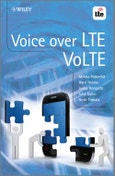Main drivers for the introduction of Long Term Evolution of UTRAN (LTE) is to provide far better end user experience for mobile broadband services. However, service providers also need to have a clear strategy of how to offer voice and messaging services for consumers and enterprises. The voice service over LTE is becoming increasingly important when the smartphone penetration is increasing rapidly. Smartphones require both good quality voice and high speed broadband data.
This book provides the exhaustive view to industry-approved technologies and standards behind the Voice over LTE (VoLTE). Whether a decision maker or technology analyst, this book explains a topic of substantial global market interest. It provides a good introduction to the technology and is useful for operators who may be deploying VoLTE, product managers responsible for VoLTE products and those who work in implementation and standardization of related technologies.
- Provides a comprehensive overview of industry-approved technologies and standards, providing vital information for decision makers and those working on the technology
- Written by authors working at the cutting edge of mobile communications technology today, bringing a mix of standards and product background, guaranteeing in-depth practical and standards information
- Covering the technical and practical elements of VoLTE, explaining the various approaches for providing voice services over LTE
Table of Contents
Preface ix
Acknowledgements xi
List of Abbreviations xiii
1 Background 1
2 VoLTE Deployment Strategies 5
2.1 Common Networks Everywhere 5
2.2 GSM/WCDMA View 6
2.3 CDMA View 6
3 VoLTE System Architecture 9
3.1 Overview 9
3.2 LTE Radio 10
3.2.1 LTE Radio Background 10
3.2.2 LTE Radio Architecture 11
3.3 Evolved Packet Core 14
3.3.1 What is the Evolved Packet Core? 14
3.3.2 EPC Entities and Functionalities 14
3.3.3 EPS Mobility Management 17
3.3.4 EPS Session Management and QoS 20
3.4 Control 22
3.4.1 What is an IP Multimedia Subsystem? 22
3.4.2 IMS Development History 23
3.4.3 IMS Fundamentals 26
3.4.4 IMS Entities 32
3.4.5 Home Subscriber Server 42
3.4.6 Policy and Charging Rule Function 43
3.5 Summary 44
4 VoLTE Functionality 47
4.1 Overview 47
4.2 Radio Functionalities 47
4.2.1 Bearers and Scheduling 47
4.2.2 Mobility 49
4.2.3 Circuit Switched Fallback Handover 51
4.2.4 Mobility from 2G/3G Back to LTE 54
4.2.5 Power Saving Features 55
4.2.6 Positioning Solutions 56
4.2.7 UE Radio Access Capabilities for VoLTE 57
4.3 EPC Functionalities 58
4.3.1 LTE subscriber identification 59
4.3.2 PDN Connectivity Establishment for the VoLTE User 60
4.3.3 EPS Dedicated Bearer Setup 65
4.4 IMS Identification 65
4.4.1 IP Multimedia Services Identity Module 66
4.4.2 Public User Identity 67
4.4.3 Private User Identity 67
4.4.4 Relationship between Private and Public User Identities 67
4.4.5 Identification of User’s Device 68
4.4.6 Identification of Network Entities 70
4.4.7 Identification of Services (Public Service Identities) 70
4.4.8 Identification Without ISIM 70
4.5 IMS Service Provisioning 71
4.5.1 Enforcement of Allowed Services 72
4.5.2 Service-Triggering Information 73
4.5.3 Selection of AS 75
4.5.4 AS Behaviour 75
4.5.5 Service Provisioning in Action 76
4.6 IMS Multimedia Telephony 79
4.6.1 Introduction 79
4.6.2 Multimedia Communication 80
4.6.3 Supplementary Services 81
5 VoLTE End to End and Signalling 99
5.1 Overview 99
5.2 VoLTE Subscription and Device Configuration 100
5.3 EPS Attach for CSFB/IMS VoIP and Default Bearer Activation 102
5.4 IMS Registration 107
5.4.1 Constructing the REGISTER Request 109
5.4.2 From the UE to the P-CSCF 110
5.4.3 From the P-CSCF to the I-CSCF 110
5.4.4 From the I-CSCF to the S-CSCF 111
5.4.5 S-CSCF Challenges the UE 111
5.4.6 UE’s Response to the Challenge 112
5.4.7 Registration at the S-CSCF 113
5.4.8 The 200 (OK) Response 113
5.4.9 Third-Party Registration to Application Servers 114
5.4.10 Subscription to Registration Event Package 115
5.4.11 Re-Registration and Re-Authentication 115
5.4.12 De-Registration 116
5.4.13 Related Standards 117
5.5 IMS VoIP Session 118
5.5.1 Constructing the INVITE Request 120
5.5.2 Routing 122
5.5.3 Media Negotiation 127
5.5.4 Media Resource Reservation and Policy Control 129
5.5.5 Charging 135
5.5.6 Session Release 141
5.5.7 Related Standards 143
5.6 Voice Continuity 144
5.6.1 PS-PS Intersystem Handover 144
5.6.2 Single Radio Voice Call Continuity 145
5.6.3 Summary 157
5.7 IMS Emergency Session 160
5.7.1 PDN Connection Setup for Emergency Session 160
5.7.2 Emergency Registration 161
5.7.3 Emergency Session 163
5.8 CS Fallback for Evolved Packet System Call Case(s) 164
5.8.1 Architecture of CS Fallback for EPS 166
5.8.2 Description of SGs Interface 168
5.8.3 Idle Mode Signalling Reduction and Use of CS Fallback for EPS 169
5.8.4 Idle Mode versus Active Mode UE with CS Fallback for EPS 172
5.8.5 CS Fallback Attachment 173
5.8.6 Mobile Originating Call Using CSFB 174
5.8.7 Mobile Terminating Call Using CSFB 180
5.8.8 Call Unrelated CSFB Procedures 187
5.8.9 Mobile Terminating Roaming Retry and Forwarding 189
5.8.10 Summary 193
5.9 VoLTE Messaging 194
5.9.1 Native IMS Messaging 194
5.9.2 SMS Interworking 196
5.9.3 Multimedia Messaging Service 214
5.9.4 Unstructured Supplementary Services Data Simulation in IMS 214
5.9.5 Summary 215
6 IMS Centralized Services 217
7 VoLTE Radio Performance 223
7.1 Coverage 223
7.2 Capacity 224
7.3 Latency 226
7.4 Summary 228
8 HSPA Voice over IP 229
References 233
Index 237








